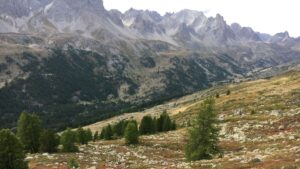ID99: Open Poster Session
Details
Full Title
Open Poster Session
Scheduled
Wednesday, 2022-09-14
17:45-18:30Convener
Stefan Mayr, President of IMC2022
Co-Conveners
Irmgard Juen, Wolfgang Gurgiser
Assigned to Synthesis Workshop
–
Keywords
Mountain Research
Description
This session invites and collects contributions from all researchers that want to be part of #IMC22 but which research does not fit well in any of the suggested sessions. The session will have oral presentations at the poster and will be moderated by the president of the #IMC22.
Registered Abstracts
Abstract ID 366 | Date: 2022-09-14 17:45 – 17:47 | Type: Poster Presentation | Place: SOWI – Garden |
Zapounidis, Konstantinos (1); Partzalidou, Parthena (1); Sancho, Alexis (1); Colomer, Rosa (2)
1: Pieriki Anaptixiaki S.A.-O.L.A., Greece
2: Ad Bergueda, Spain
Keywords: Sustainability, Tourism, Eco-Itinerary, Eu, Strategy
The Emblematic Mediterranean Mountains network has created several tools for the implementation and development of sustainable tourism products in the hinterland of several Mediterranean mountains.
These tools are being tested at several levels with several, new to the network mountains, under several EU funded programmes and strategies (Interreg MED and CLLD/Leader Programme). In more detail, the transferability guide and the study on the Emblematic dimension, that have been elaborated within the Interreg MED programme “EMbleMatiC” project, have been adapted by new areas in the effort to either define sustainable tourism products (eco-itineraries) with specific predefined attributes or to test the potentiality of entering the Emblematic Mediterranean Mountains network with specific criteria.
These processes would be analyzed and the results will be presented, defining the transferability level of the tools created and the dynamic offered by EU strategies to adapt such tools.
Abstract ID 136 | Date: 2022-09-14 17:47 – 17:49 | Type: Poster Presentation | Place: SOWI – Garden |
Antonescu, Daniela
Center of Mountain Economy, Romania
Keywords: Food Waste, Sustainable Development, Environmental Policies
Food waste in Romania represents a major social problem: statistics indicate 5 million tons of food waste annually, representing between one third and a half of the total amount of food for human consumption produced in a year (about 250 kg / inhabitant). Annually, about a third of the products bought in Romania end up in the trash or are wasted unnecessarily. This quantity corresponds to about 2.55 million tons of food, respectively to the load of 127,500 trucks lined up from Bucharest to Munich. Every Romanian wastes an average of 353 grams of food per day in the household and over 6,000 tons of food end up in the garbage every day. The greatest waste of food is registered in the urban environment, while the rural communities use traditional methods of capitalization of food waste in the household. In the urban environment, over 95% of the municipal waste reaches the landfill, thus making it impossible to capitalize on waste of any kind, both food and non-food.Present paper seeks to provide an overview regarding the phenomenon of food waste in Romania. It also presents the conclusions resulting from interviews and questionnaires with the owners of agro-mountain boarding houses on how they manage this phenomenon with a negative impact on life and the environment. The conclusions will also present a series of measures that can contribute to reducing food waste in Romania.
Abstract ID 127 | Date: 2022-09-14 17:49 – 17:51 | Type: Poster Presentation | Place: SOWI – Garden |
Gatera, Etienne
Pedagogical University of Krakow, Poland
Keywords: Land -Use Management, Mountain Jali, Mountain Kigali, Population Decline, Rwanda
Rwanda was one of the sub-Saharan Africa (SSA) countries that experienced a population boom in 1995 after the Tutsi genocide. With 6.17 children per female and 495 inhabitants per km2 in 2019, human being intervention against the environment become more and more, such. deforestation, reoccupation of state-owned land such Parks, Mountains, places near to Rivers and Swamps), and resulted in deterioration of the environment, natural hazards including loss of soil and people life, . The purpose of this study is to clarify the impact of controlling population growth on land-use management and to focus on the problems faced by the inhabitants of Mountains Jali and Kigali in Rwanda. Due to the lack of sufficient research on this subject, this research uses qualitative questionnaires and statistical methods to investigate trends in all declining populations and high-risk areas of Jali and Kigali mountains. The use an observational approach by mapping the inhabitants, with a randomized block design (RBD) technique. Current projects could potentially be used by authorities to track the location of high-risk zones and help governments develop better environmental policies in the future. We mainly analysed the role of population decline as the main contributing factor to land use management, and the literature identified many issues such as settlement in high-risk areas, areas degradation, general environmental problems.
Abstract ID 569 | Date: 2022-09-14 17:51 – 17:53 | Type: Poster Presentation | Place: SOWI – Garden |
Yusuk, Pedcharada; Yodyadthai, Arnon; Klomjoho, Datapon; Woranasit, Suphakit
็Highland Research and Development Institute, HRDI, Thailand
Keywords: Land-Use, Agricultural System, Knowledges, Participatory
Highlands in Thailand include the areas elevating from 500 m above sea level upwards, covering 9.12 million hectares, populating 15 indigenous tribes. The major problem occurring in the highlands has long been forest invasion due to slash and burn agricultural system of the hill tribes. The on-going of such cultivation of vegetables and maze leads to the conflict between the highlanders and the government. Highland Research and Development Institute (HRDI), a public organization, was established in 2005, dealing with highland development, aiming at harmonious and sustainable coexistence of people and forests. HRDI collaborates with 616 communities in 8 northern provinces including 67,327 households of 256,955 people. Area approaches are determined by integrated collaboration among several governmental agencies complemented by community participatory. The work scheme, concluded by the Royal Forestry Department, state local administration and communities, under HRDI’s supervision, composes land use planning, GIS forest border marking and residential area mapping. In practice, suitable agricultural systems are designed for highland farmers in different areas by designated field staff. The cultures of growing maze and upland rice are modified to integrated outdoor farming of subtropical fruits, such as peach, plum and persimmon, coffee, annual vegetables, such as lettuce, pak-choi and kale. For less elevated lands, being classified as the uplands, greenhouse culture is appropriate while in the lowlands paddy field rice cultivation is suggested. Apparently, modifications of agricultural systems as mentioned earlier can reduce the problems of smog and pollution caused by burning to some extent. The hot spots in our responsible areas were 30% declined, i.e. from 7,322 in 2020 to 2,187 in 2021. Apart from those attempts stated above, we also created connections between farmers and markets. In 2020, the farmers made their income worth 402.16 million baht from vegetables, fruits, coffee, livestock and so on. The key success to the whole scheme is the hand joining among working sectors, stakeholders and communities, on the basis of knowledge sharing, appropriate supports and participation. Above all, community’s choices count.
Abstract ID 957 | Date: 2022-09-14 17:53 – 17:55 | Type: Poster Presentation | Place: SOWI – Garden |
Aschaber, Andreas (1); Schuster, Helmut (2); Rotvnik, Bojan (1); Seliger, Bogdan (3); Jiroudkova, Petra (2); Simonovski, Simon (4); Harnochova, Jana (2); Latorre, Angelo (5); Mair, Hanspeter (6); Tomalova, Eiliska (7)
1: European Union of Mountaineering Associations, Belgium
2: European Ramblers Association, Germany
3: PZS, Slovenia
4: FPSM, North Macedonia
5: FIE, Italy
6: DAV, Germany
7: CUNI, Czech Republic
Keywords: Hiking Trails, Mountain Trails, Sustainable Trail Management, European Cohesion
Marked trails, whether in in the mountains or in the lowlands support recreational sports like hiking, running, mountaineering, climbing and serve many other users. Trails connect people across countries in the same way as streets or railways and therefore serve an important function for European cohesion. Basically, walking, hiking, and mountain trails are footpaths in the public interest for the purpose of walking, running, or climbing, located in all landscapes, visible and clearly recognised in the terrain and are physically marked and signposted.
Proper management is required to keep trails in appropriate condition which is done by national hiking and mountaineering associations which are represented by the European Union of Mountaineering Associations (EUMA) and the European Ramblers Association (ERA).
Trails have a very important function for visitor guidance in each European country. They guide people with the help of markings and signposts through difficult terrain, complex landscapes, or environmentally sensitive areas. The latter is highly important since it helps people to stick to a certain route without damaging the nature. This function has become very important, especially since the demand for relaxation and exercise in nature has increased and amplified the pressure on nature in the last couple of years.
The existence of trails is at stake due to missing legal status in many European countries. Trails lose their attractiveness due to sealing or merging in urban structures. Furthermore, ownership conflicts and the lack of funds are generally leading to the closure of trails while the impact of climate change increases the maintenance effort. A fundamental problem is the lack of understanding they facilitate the wellbeing of a society. They are generally taken for granted without knowing about the efforts standing behind.
There are more then 1,5 million km of trails across Europe which are mostly voluntarily maintained by national associations. There is no European-wide trail register which could ensure a sustainable European-wide trail management system to preserve nature and allow individuals’ a responsible outdoor experience under the free right to roam.
The study which was conducted in 30 European countries where data was retrieved from 37 leading hiking and mountaineering associations revealed results on existing national trail management systems. These comprise details about structure, costs, composition, legal status, and major obstacles for trails. From these rich data, recommendations for sustainable trail management where derived to develop a more nature sensitive approach to trails management.
Abstract ID 952 | Date: 2022-09-14 17:55 – 17:57 | Type: Poster Presentation | Place: SOWI – Garden |
Chacón, Martina Ayelén; Villalba, Ricardo; Srur, Ana
IANIGLA, Argentine Republic
Keywords: Xylogenesis, Dendrochronology, Cambial Activity
At a global scale, there is high and growing concern about the effects that the observed and predicted climate variability will have on forest ecosystems in the 21st century. Climatic variations directly affect the rate of tree growth and indirectly determine the frequency, magnitude and type of forest disturbances. Based on a tree-centered approach, this doctoral plan proposes to study in detail the potential responses of Nothofagus pumilio to environmental changes, associated with global warming. Indeed, the general objective of this research work is to analyze the radial tree growth in response to climatic variations in the Patagonian forest, both on hourly, interannual and longer-term time scales. The hypothesis being tested suggests that the temperature variations and the availability of humidity in the soil interact with each other, modulating the radial growth of woody species. It also argues that temperature is the main factor that controls the onset of xylogenesis, but it covaries with humidity throughout the growing season. In this way, variations in type, dimension and arrangement of wood tissues are influenced by climate variations. As part of the methodology to be used, real time monitoring will be carried out to study wood formation and environmental variables, in conjunction with retrospective dendrochronological analysis of radial growth. Valid estimates of native forests response to climate and variability will also be provided in different time scales. The tree-centered approach, which guides this doctoral thesis, represents a valuable contribution to estimate changes in Argentine forests’ growth and structure, in a context of climate change.
Abstract ID 961 | Date: 2022-09-14 18:07 – 18:09 | Type: Poster Presentation | Place: SOWI – Garden |
Snethlage, Mark Alexander (1); Geschke, Jonas (2); Spehn, Eva M. (3); Ranipeta, Ajay (4); Yoccoz, Nigel G. (5); Körner, Christian (6); Jetz, Walter (7); Fischer, Markus (2); Urbach, Davnah (1)
1: Global Mountain Biodiversity Assessment, University of Bern, Switzerland
2: Institute of Plant Sciences, University of Bern, Switzerland
3: Swiss Academy of Sciences (SCNAT), Bern, Switzerland
4: School for Forestry and the Environment, Yale University, New Haven, United States
5: Department of Arctic and Marine Biology, UiT The Arctic University of Norway, Tromsø, Norway
6: Department of Environmental Sciences, Botany, University of Basel, Basel, Switzerland
7: Department of Ecology and Evolutionary Biology, Yale University, New Haven, United States
Keywords: Global, Mountain Range, Digital Map, Inventory, Hierarchical
A standardized delineation of the worlds’ mountains has many applications in research, education, and the science-policy interface. Here we provide a new inventory of 8616 mountain ranges developed under the auspices of the Global Mountain Biodiversity Assessment (GMBA). Building on an earlier compilation, the presented geospatial database uses a further advanced and generalized mountain definition and a semi-automated method to enable globally standardized, transparent delineations of mountain ranges worldwide. The inventory is presented on EarthEnv at various hierarchical levels, allowing users to select their preferred level of regional aggregation from continents to small subranges according to their needs and the scale of their analyses. The clearly defined, globally consistent and hierarchical nature of the presented mountain inventory offers a standardized resource for referencing and addressing mountains across basic and applied natural, social sciences research and a range of other uses in science communication and education.
Abstract ID 231 | Date: 2022-09-14 18:19 – 18:21 | Type: Poster Presentation | Place: SOWI – Garden |
Sherpa, Tsewang
Lincoln University, New Zealand
Keywords: Garbage Deposit Scheme, Nepal, Mount Everest, Environmental Policy, Waste Management
Waste on Mt Everest is often treated as ‘out of sight, out of mind’ – discarded into the nearest receptacle and promptly forgotten. The accumulation of solid waste on the world’s highest mountain’s camping sites (Base Camp and high camps) has been a chronic problem since mountaineering first became popular in 1951 and has further intensified with the steady acceleration of mountaineering in the past four decades. The implementation of the Garbage Deposit Scheme (GDS) was a government intervention aimed at solving waste management issues on Mt Everest. The evaluation of the GDS is important to understanding whether the results achieved correspond to the policy goals and to identifying obstacles to and outlining strategies for any necessary improvements. Such a study has not been conducted. This study assesses the effectiveness of the GDS. Empirical analysis was carried out to evaluate whether waste management on Mt Everest has improved. The findings suggest that the GDS has not accomplished the desired changes in waste management, particularly because of its low acceptance among stakeholders and low government support. This study highlights major obstacles to the GDS’s implementation. The study concludes with potential recommendations that could improve the scheme.



